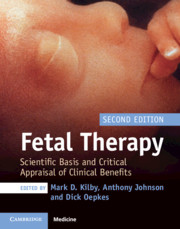Book contents
- Fetal Therapy
- Fetal Therapy
- Copyright page
- Dedication
- Contents
- Contributors
- Foreword
- Section 1: General Principles
- Section 2: Fetal Disease: Pathogenesis and Treatment
- Red Cell Alloimmunization
- Structural Heart Disease in the Fetus
- Fetal Dysrhythmias
- Manipulation of Fetal Amniotic Fluid Volume
- Fetal Infections
- Fetal Growth and Well-being
- Chapter 23 Fetal Growth Restriction: Placental Basis and Implications for Clinical Practice
- Chapter 24 Fetal Growth Restriction: Diagnosis and Management
- Chapter 25 Screening and Intervention for Fetal Growth Restriction
- Chapter 26 Maternal and Fetal Therapy: Can We Optimize Fetal Growth?
- Preterm Birth of the Singleton and Multiple Pregnancy
- Complications of Monochorionic Multiple Pregnancy: Twin-to-Twin Transfusion Syndrome
- Complications of Monochorionic Multiple Pregnancy: Fetal Growth Restriction in Monochorionic Twins
- Complications of Monochorionic Multiple Pregnancy: Twin Reversed Arterial Perfusion Sequence
- Complications of Monochorionic Multiple Pregnancy: Multifetal Reduction in Multiple Pregnancy
- Fetal Urinary Tract Obstruction
- Pleural Effusion and Pulmonary Pathology
- Surgical Correction of Neural Tube Anomalies
- Fetal Tumors
- Congenital Diaphragmatic Hernia
- Fetal Stem Cell Transplantation
- Gene Therapy
- Section III: The Future
- Index
- References
Chapter 26 - Maternal and Fetal Therapy: Can We Optimize Fetal Growth?
from Fetal Growth and Well-being
Published online by Cambridge University Press: 21 October 2019
- Fetal Therapy
- Fetal Therapy
- Copyright page
- Dedication
- Contents
- Contributors
- Foreword
- Section 1: General Principles
- Section 2: Fetal Disease: Pathogenesis and Treatment
- Red Cell Alloimmunization
- Structural Heart Disease in the Fetus
- Fetal Dysrhythmias
- Manipulation of Fetal Amniotic Fluid Volume
- Fetal Infections
- Fetal Growth and Well-being
- Chapter 23 Fetal Growth Restriction: Placental Basis and Implications for Clinical Practice
- Chapter 24 Fetal Growth Restriction: Diagnosis and Management
- Chapter 25 Screening and Intervention for Fetal Growth Restriction
- Chapter 26 Maternal and Fetal Therapy: Can We Optimize Fetal Growth?
- Preterm Birth of the Singleton and Multiple Pregnancy
- Complications of Monochorionic Multiple Pregnancy: Twin-to-Twin Transfusion Syndrome
- Complications of Monochorionic Multiple Pregnancy: Fetal Growth Restriction in Monochorionic Twins
- Complications of Monochorionic Multiple Pregnancy: Twin Reversed Arterial Perfusion Sequence
- Complications of Monochorionic Multiple Pregnancy: Multifetal Reduction in Multiple Pregnancy
- Fetal Urinary Tract Obstruction
- Pleural Effusion and Pulmonary Pathology
- Surgical Correction of Neural Tube Anomalies
- Fetal Tumors
- Congenital Diaphragmatic Hernia
- Fetal Stem Cell Transplantation
- Gene Therapy
- Section III: The Future
- Index
- References
Summary
Difficulties with the diagnosis, management and treatment of fetal growth problems start with defining which small fetus or newborn is affected by fetal growth restriction (FGR). A small for gestational age (SGA) fetus is diagnosed when its estimated fetal weight (EFW), or its components such as abdominal circumference (AC), fall below the 10th centile for the given gestation. This definition will include both healthy small fetuses and those who fail to reach their growth potential and who are considered to have FGR. There are many factors known to contribute to the reduction of fetal growth velocity, such as chromosomal anomalies, genetic syndromes and infections as well as maternal and environmental factors, including poor periconceptual diet and cigarette smoking. Other known risk factors for FGR include maternal co-morbidities, especially preexisting hypertensive disorders, the use of assisted reproductive techniques, and obstetric complications like heavy, recurrent vaginal bleeding or loss of co-twin.
- Type
- Chapter
- Information
- Fetal TherapyScientific Basis and Critical Appraisal of Clinical Benefits, pp. 287 - 301Publisher: Cambridge University PressPrint publication year: 2020

